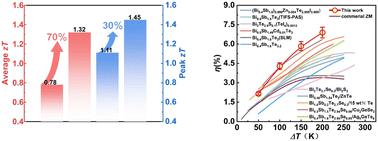当前位置:
X-MOL 学术
›
Energy Environ. Sci.
›
论文详情
Our official English website, www.x-mol.net, welcomes your
feedback! (Note: you will need to create a separate account there.)
Ultra-low lattice thermal conductivity realizing ultra-high performance Bi0.48Sb1.52Te3-based thermoelectric material and module
Energy & Environmental Science ( IF 32.4 ) Pub Date : 2024-07-16 , DOI: 10.1039/d4ee02008a Hongtao Li 1, 2 , Lidong Chen 2 , Zhe Guo 2 , Gang Wu 2 , Xiaojian Tan 2 , Qiang Zhang 2 , Jianfeng Cai 2 , Qianqian Sun 2 , Jacques G. Noudem 3 , Peng Sun 2 , Jiehua Wu 2 , Guo-Qiang Liu 2 , Jun Jiang 2
Energy & Environmental Science ( IF 32.4 ) Pub Date : 2024-07-16 , DOI: 10.1039/d4ee02008a Hongtao Li 1, 2 , Lidong Chen 2 , Zhe Guo 2 , Gang Wu 2 , Xiaojian Tan 2 , Qiang Zhang 2 , Jianfeng Cai 2 , Qianqian Sun 2 , Jacques G. Noudem 3 , Peng Sun 2 , Jiehua Wu 2 , Guo-Qiang Liu 2 , Jun Jiang 2
Affiliation

|
The component regulation in Bi2Te3-based materials usually simultaneously decreases the lattice thermal conductivity and carrier mobility, which makes it difficult to improve the thermoelectric performance. In this work, we aim to improve the zT of p-type Bi0.48Sb1.52Te3 by adding Sn1/3Ge1/3Pb1/3Te and Cu to introduce differentiated electro–phonon scattering centres to reduce the lattice thermal conductivity while maintaining the carrier mobility as much as possible. Sn1/3Ge1/3Pb1/3Te alloying produces many point defects and a Te-poor characteristic, thus inducing twin and low-angle grain boundaries to effectively strengthen the phonon scattering, and realizing an ultralow lattice thermal conductivity of 0.42 W m−1 K−1 at 300 K. Simultaneously, Cu doping optimizes the hole concentration, boosting the power factor overall to an average value of 32.1 μW cm−1 K−2 within 300–500 K. These synergistic effects yield a peak zT of 1.45 at 375 K and an average zT of 1.32 (300–500 K) in the Bi0.48Sb1.516Cu0.004Te3 + 0.50 wt% Sn1/3Ge1/3Pb1/3Te sample. The integrated 17-pair thermoelectric module achieves a conversion efficiency of 6.8% at ΔT = 200 K when coupled with n-type zone-melted Bi2Te2.7Se0.3. More importantly, the output performance of the fabricated module did not weaken after 100 cycles in a 500 hours aging test.
中文翻译:

超低晶格热导率实现超高性能Bi0.48Sb1.52Te3基热电材料和模块
Bi 2 Te 3 基材料中的组分调节通常会同时降低晶格热导率和载流子迁移率,这使得热电性能难以提高。在这项工作中,我们的目标是通过添加 Sn 1/3 Ge < 来提高 p 型 Bi 0.48 Sb 1.52 Te 3 的 zT b6> Pb 1/3 Te和Cu引入差异化的电声子散射中心,以降低晶格热导率,同时尽可能保持载流子迁移率。 Sn 1/3 Ge 1/3 Pb 1/3 Te合金化产生许多点缺陷和较差的Te特性,从而诱发孪晶和小角度晶界,有效强化声子散射,并在 300 K 下实现 0.42 W m −1 K −1 的超低晶格热导率。同时,Cu 掺杂优化了空穴浓度,将整体功率因数提高到平均水平300–500 K 范围内的 zT 值为 32.1 μW cm −1 K −2 。这些协同效应在 375 K 时产生 1.45 的峰值 zT,平均 zT 为 1.32 (300–500 K) Bi 0.48 Sb 1.516 Cu 0.004 Te 3 + 0.50 wt% Sn 1/3 Ge 1/3 Pb 1/3 Te 样品。当与n型区熔Bi 2 Te 2.7 Se 0.3
更新日期:2024-07-16
中文翻译:

超低晶格热导率实现超高性能Bi0.48Sb1.52Te3基热电材料和模块
Bi 2 Te 3 基材料中的组分调节通常会同时降低晶格热导率和载流子迁移率,这使得热电性能难以提高。在这项工作中,我们的目标是通过添加 Sn 1/3 Ge < 来提高 p 型 Bi 0.48 Sb 1.52 Te 3 的 zT b6> Pb 1/3 Te和Cu引入差异化的电声子散射中心,以降低晶格热导率,同时尽可能保持载流子迁移率。 Sn 1/3 Ge 1/3 Pb 1/3 Te合金化产生许多点缺陷和较差的Te特性,从而诱发孪晶和小角度晶界,有效强化声子散射,并在 300 K 下实现 0.42 W m −1 K −1 的超低晶格热导率。同时,Cu 掺杂优化了空穴浓度,将整体功率因数提高到平均水平300–500 K 范围内的 zT 值为 32.1 μW cm −1 K −2 。这些协同效应在 375 K 时产生 1.45 的峰值 zT,平均 zT 为 1.32 (300–500 K) Bi 0.48 Sb 1.516 Cu 0.004 Te 3 + 0.50 wt% Sn 1/3 Ge 1/3 Pb 1/3 Te 样品。当与n型区熔Bi 2 Te 2.7 Se 0.3

















































 京公网安备 11010802027423号
京公网安备 11010802027423号